Evaluation of Potential Changes in Extreme Discharges over Some Watersheds in Côte d’Ivoire
Abstract
1. Introduction
2. Materials and Methods
2.1. Study Area
2.2. Data Used
2.3. Interannual Variation of Discharge
2.4. Description and Extraction of Extreme Discharge Indices
2.5. Detection of Trends and Breakpoints in the Discharge Series
2.5.1. Modified Mann–Kendall Test
2.5.2. Standard Normal Homogeneity Test (SNHT)
3. Results
3.1. Interannual Variation Discharge
3.2. Considering Heterogeneous Periods for the Trend and Breakpoint Analyses
3.2.1. Trend Analysis for High- and Low-Discharge Indices
3.2.2. Breakpoint Detection for High- and Low-Discharge Indices
3.3. Considering Homogeneous Periods for the Trend and Breakpoint Analyses
3.3.1. Trend Analysis Results for Flooding and Low-Discharge Indices
3.3.2. Breakpoint Detection
4. Discussion
4.1. High Discharge Rates and Their Implications
4.2. Low Discharge Rates and Their Implications
4.3. Differences in Outputs from Heterogeneous and Homogeneous Periods
5. Conclusions
Author Contributions
Funding
Institutional Review Board Statement
Informed Consent Statement
Data Availability Statement
Acknowledgments
Conflicts of Interest
Appendix A

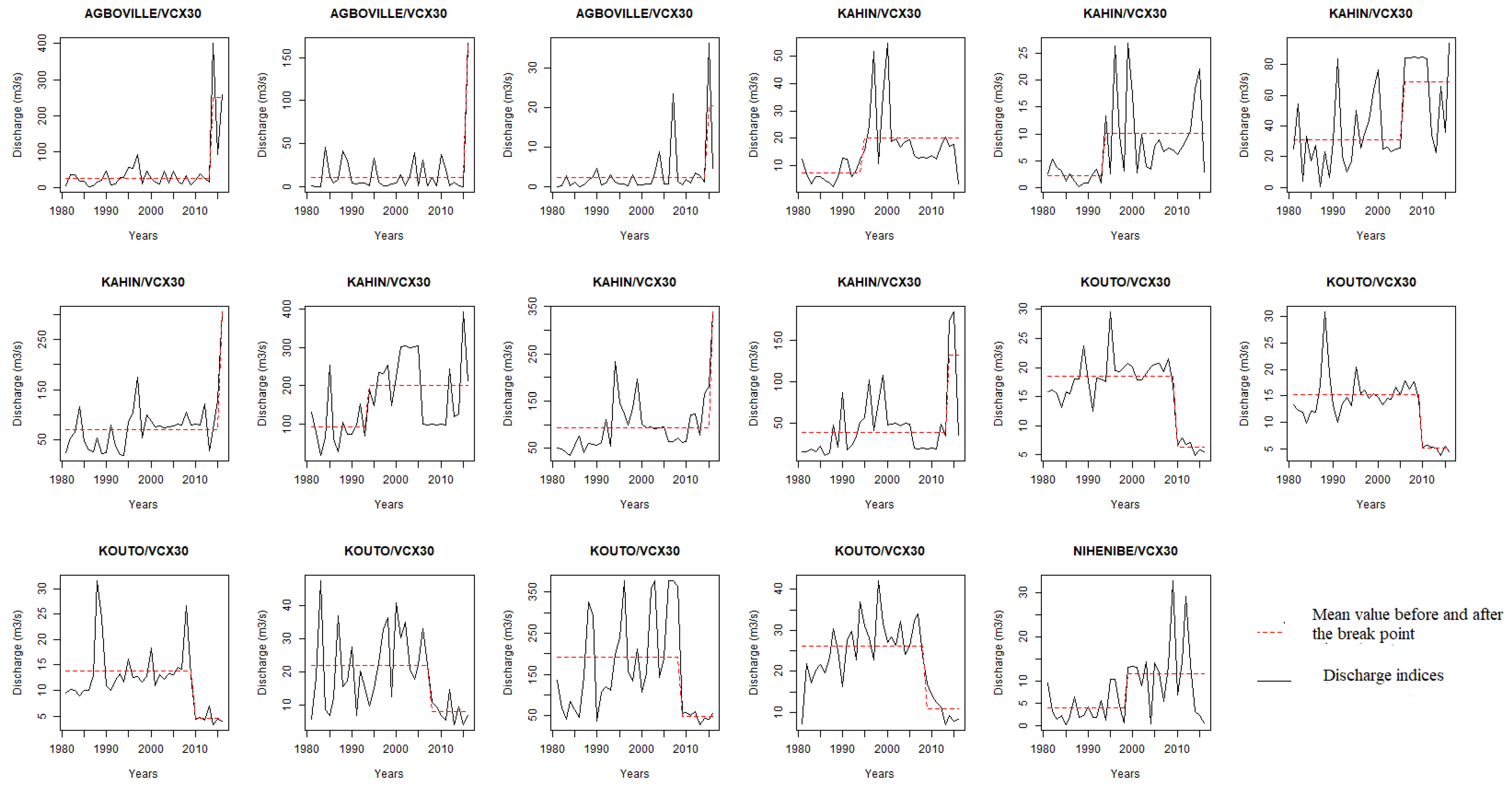
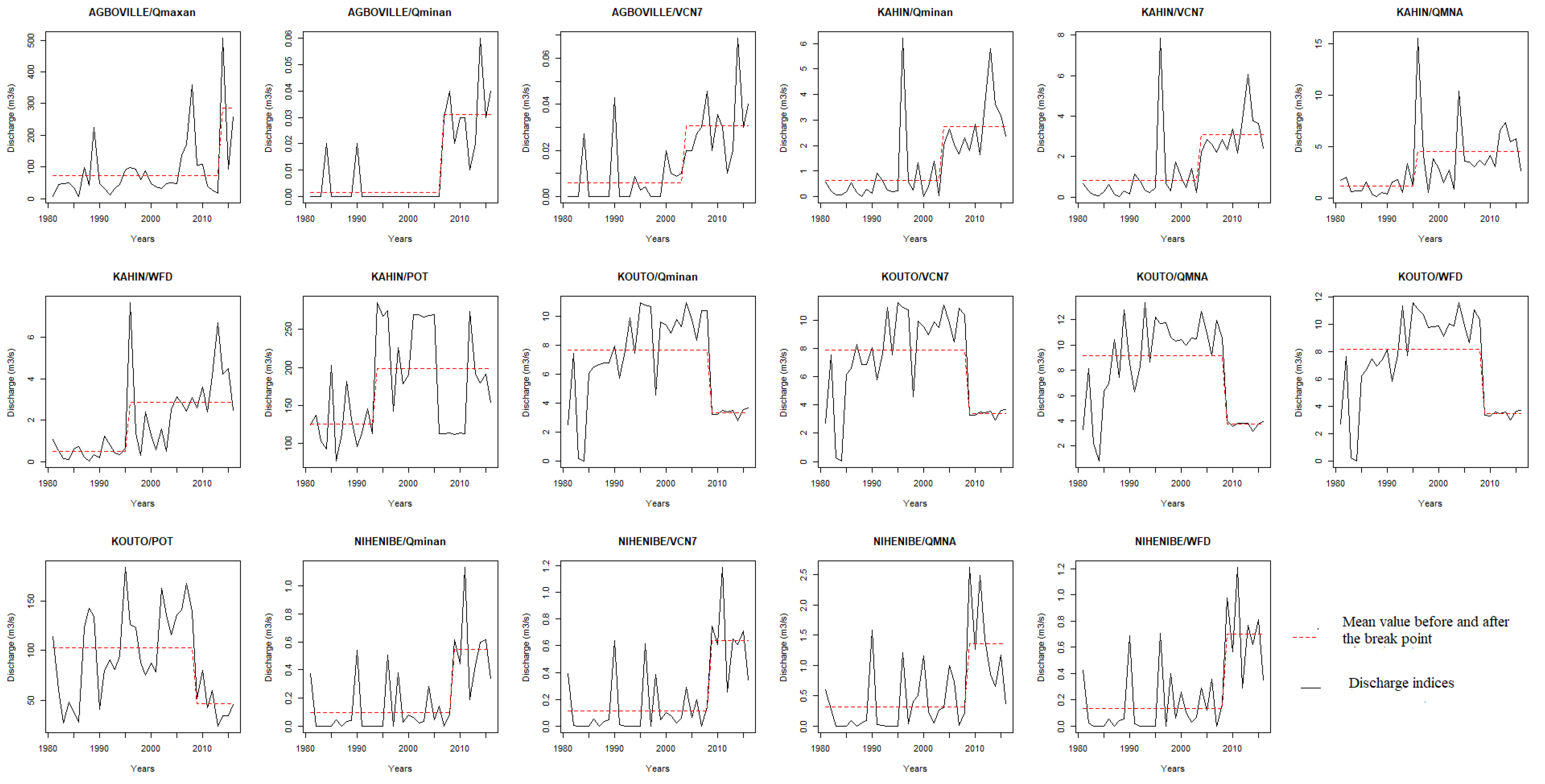
References
- Meliho, M.; Khattabi, A.; Jobbins, G.; Sghir, F. Impact of meteorological drought on agriculture in the Tensift watershed of Morocco. J. Water Clim. Change 2019, 11, 1323–1338. [Google Scholar] [CrossRef]
- Abdoulaye, B.; Clobite, B.B.; Bell, J.P.; Issak, A.; Robert, M.L.B. Évolution des indices des extrêmes climatiques en République du Tchad de 1960 à 2008. Atmo-Ocean 2017, 55, 42–56. [Google Scholar]
- Nyirenda, K.; Emmanuel, S. Trend Analysis of Extreme Rainfall in Zambia and Its Potential Implication on Water Resources Availability and Agricultural Productivity. Am. J. Geochem. Geophys. Geosyst. 2019, 5, 10–15. [Google Scholar]
- Botai, C.M.; Joel, O.B.; Nosipho, N.Z.; Patrick, H.; Eric, K.W.; Thabo, M.; Miriam, D.M.; Abiodun, M.A.; Katlego, P.N.; de Wit Jaco, P.; et al. Hydroclimatic Extremes in the Limpopo River Watershed, South Africa, under Changing Climate. Water 2020, 12, 3299. [Google Scholar] [CrossRef]
- Attogouinon, A.; Agnidé, E.L.; M’Po, Y.N.; Rita, H. Extreme Precipitation Indices Trend Assessment over the Upper Oueme River Valley-(Benin). Hydrology 2017, 4, 36. [Google Scholar] [CrossRef]
- Adeyeri, O.; Ishola, K.; Okogbue, E. Climate change and coastal floods: The susceptibility of coastal areas of Nigeria. J. Coast. Zone Manag. 2017, 20, 443. [Google Scholar]
- Abiodun, B.J.; Adegoke, J.; Abatan, A.A.; Ibe, C.A.; Egbebiyi, T.S.; Engelbrecht, F.; Pinto, I. Potential impacts of climate change on extreme precipitation over four African coastal cities. Clim. Change 2017, 143, 399–413. [Google Scholar] [CrossRef]
- Mohamed, F.; Julien, A.; Isaac, L.; Jean, H.; Djan’na, K.; Adama, T.; Hamadoun, B.; Sam-Quarcoo, D.; Andrew, M.L. Urban flash flood and extreme rainfall events trend analysis in Bamako, Mali. Environ. Chall. 2022, 6, 100449. [Google Scholar]
- Ozer, P.; Ousmane, L.M.; Adamou, D.T.; Bakary, D.; Florence DE, L. Evolution récente des extrêmes pluviométriques au Niger (1950–2014). Geo-Eco-Trop 2017, 41(3), 375–383. [Google Scholar]
- Larbi, I.; Fabien, C.C.H.; Thompson, A.; Wilson, A.A.; John, M.G.; Joshua, A. Spatio-Temporal Trend Analysis of Rainfall and Temperature Extremes in the Vea Watershed, Ghana. Climate 2018, 6, 87. [Google Scholar] [CrossRef]
- Kouassi, K.M.; Yao, K.B.; Kouassi, K.L.; Biemi, J.; Soro, N. Extreme flow variability analysis at the Bianouan hydrometric station on the Bia River watershed in Côte d’Ivoire. Proc. IAHS 2020, 383, 319–325. [Google Scholar] [CrossRef]
- Assoma, V.T.; Adiaffi, B.; Koudou, A. Influence de la Variabilité Climatique sur les Réserves en eau du sol et dans les Systèmes Agricoles du Bassin Côtier de l’Agnéby (Côte d’Ivoire). Eur. J. Scie. Res. 2016, 143, 186–202. [Google Scholar]
- Assoko, A.V.S.; Kouassi, A.M.; Nassa, R.A.K. Modélisation statistique des débits d’étiages et détermination de seuils d’étiages dans le bassin versant de la marahoué (bandama, côte d’ivoire). Larhyss J. 2020, 41, 121–147. [Google Scholar]
- RNC, 2021: Rapport des Consultations Nationales en Côte D’Ivoire. p. 80. Available online: https://www.floodmanagement.info (accessed on 5 December 2022).
- Affoué, B.Y.; Bi Tié Albert, G.; Alioune, K.; Oi, M.J.M.; Kouamé, A.K. Cartographie du potentiel en eau souterraine du bassin versant de la Lobo (Centre-Ouest, Côte d’Ivoire): Approche par analyse multicritère. Hydrol. Sci. J. 2016, 61, 856–867. [Google Scholar]
- Deguy, A.J.-P. Evaluation de la Vulnérabilité à l’Érosion Hydrique des Sols du Bassin Versant de la Lobo (Côte d’Ivoire): Approche par Modélisations. Ph.D. Thesis, Géosciences et Environnement, Université de Nangui Abrogoua, Abidjan, Côte d’Ivoire, 2021; p. 238. [Google Scholar]
- Adja, M.G.; Djémin, E.J.; N’Dri Franck, A.; Tohouri, P.; Kouamé, K.J.; Jourda, J.P. Apport de l’Analyse Hydrologique et de la Modélisation de la Relation Pluie-Débit dans le Suivi Quantitatif des Ressources en Eau dans un Contexte de Variabilité Climatique: Cas du Sous-Bassin Versant du Kouto (Nord de la Côte d’Ivoire). Eur. J. Sci. Res. 2019, 154, 192–212. [Google Scholar]
- Coulibaly, K.A. Impacts de la Variabilité Récente de la Pluviométrie sur les Paramètres Agroclimatiques Majeurs et les Calendriers Agricoles pour une Corrélation avec le Système Couplé Océan-Atmosphère en Côte D’Ivoire. Ph.D. Thesis, Géographie, Université Félix Houphouët-Boigny, Abidjan, Cote D’Ivoire, 2021; p. 360. [Google Scholar]
- Ehuitché, B.T. An analysis of dynamics of deforestation and agricultural productivity in Côte d’Ivoire. Inter. Res. J. Agric. Sci. Soil Scie. 2015, 5, 103–111. [Google Scholar]
- Goula, A.B.T.; Gneneyougo Soro, E.; Kouassi, W.; Srohourou, B. Tendances et ruptures au niveau des pluies journalières extrêmes en Côte d’Ivoire (Afrique de l’Ouest). Hydrol. Sci. J. 2012, 57, 1067–1080. [Google Scholar] [CrossRef]
- Tyson, P.D.; Dyer, T.G.; Mametse, M.N. Security changes in South African rainfall: 1880 to 1972. Q. J. R. Meteorol. Soc. 1975, 101, 817–833. [Google Scholar] [CrossRef]
- Blé, A.F.Y.; Emile, G.S. Detection of Hydrologic Trends and Variability in Transboundary Cavally Watershed (West Africa). Am. J. Water Res. 2021, 9, 92–102. [Google Scholar] [CrossRef]
- Yao, A.B. Evaluation des Potentialités en eau du Bassin Versant de la Lobo en Vue d’Une Gestion Rationnelle (Centre-Ouest de la Côte d’Ivoire). Ph.D. Thesis, Université Nangui Abrogoua, Abidjan, Côte d’Ivoire, 2015; 330p. [Google Scholar]
- Maochuan, H.; Takahiro, S.; Weili, D.; Kaoru, T.; Bin, H.; Pingping, L. Assessment of hydrological extremes in the Kamo River Basin, Japan. Hydrolog. Sci. J. 2017, 62, 1255–1265. [Google Scholar] [CrossRef]
- Kouassi, A.M.; Koffi, Y.B.; Nassa, R.A.K.; Kouame, K.F.; Biemi, J. Prévision saisonnière des débits de basses eaux au sein des bassins fluviaux de l’afrique de l’ouest: Cas du bassin versant du n’zi-bandama, Côte D’Ivoire. Rev. Ivoir. Sci. Technol. 2018, 32, 153–171. [Google Scholar]
- Gailliez, S. Low Discharge Discharge Estimation at Ungauged Sites. Application in Walloon Region. Ph.D. Thesis, Université of Liège, Liège, Belgium, 2013; p. 272. [Google Scholar]
- Garcia, F. Amélioration d’Une Modélisation Hydrologique Régionalisée Pour Estimer Les Statistiques D’Etiage. Ph.D. Thesis, Université Pierre et Marie Curie, Paris, France, 2016; p. 273. [Google Scholar]
- Anouman, D.G.-L.; N’go, Y.A.; Soro, G.E.; Bi, T.A.G. Spatial and Temporal Evolution of Low Water Discharges in the Sassandra River Watershed Area in Côte d’Ivoire. J. Geo Environ. Protec. 2019, 7, 184–202. [Google Scholar] [CrossRef]
- Piniewski, M.; Marcinkowski, P.; Kundzewicz, Z.W. Trend detection in river flow indices in Poland. Acta Geophys. 2018, 66, 347–360. [Google Scholar] [CrossRef]
- Lang, C. Les Étiages: Définitions Hydrologique, Statistique et Seuils Réglementaires. Cybergeo Eur. J. Geogr. Environ. Nat. Paysage; Mis en Ligne le 30 Novembre 2011. Available online: http//journals.openedition.org/cybeo/24827 (accessed on 5 December 2022).
- Hamed, K.H.; Rao, A.R. A modified Mann–Kendall trend test for autocorrelated data. J. Hydrol. 1998, 204, 82–196. [Google Scholar] [CrossRef]
- Sandeep, K.P.; O’Br, N. Modifiedmk: Modified Versions of Mann Kendall and Spearman’s Rho Trend Tests, 2021. R Package Version 1.6. Available online: https://cran.r-project.org/web/packages/modifiedmk/modifiedmk.pdf (accessed on 5 December 2022).
- Ilori, O.W.; Ajayi, V.O. Change Detection and Trend Analysis of Future Temperature and Rainfall over West Africa. Earth Syst. Environ. 2020, 4, 493–512. [Google Scholar] [CrossRef]
- Gadedjisso, T.A.; Adjegan, K.I.; Kablan, A.K.M. Rainfall and Temperature Trend Analysis by Mann–Kendall Test and Significance for Rainfed Cereal Yields in Northern Togo. Science 2021, 3, 17. [Google Scholar] [CrossRef]
- Javari, M. Trend and Homogeneity Analysis of Precipitation in Iran. Climate 2016, 4, 44. [Google Scholar] [CrossRef]
- Hänsel, S.; Medeiros, D.M.; Matschullat, J.; Petta, R.A.; De Mendonça, S.I. Assessing Homogeneity and Climate Variability of Temperature and Precipitation Series in the Capitals of North-Eastern Brazil. Front. Earth Sci. 2016, 4, 29. [Google Scholar] [CrossRef]
- Traore, V.B.; Giovani, M.; Sarr, J.; Diaw, A.T. Detection of inhomogeneities and break points in annual detection of inhomogeneities and break points in annual rainfall series of Senegal regions trend assessment over the upper oueme river valley-(Benin). Hydrology 2018, 4, 36. [Google Scholar]
- Jenifer, M.A.; Jha, M.K. Assessment of precipitation trends and its implications in the semi-arid region of Southern India. Environ. Chall. 2021, 5, 100269. [Google Scholar] [CrossRef]
- Thorsten Pohlert Trend: Non-Parametric Trend Tests and Change-Point Detection. 2020. R Package Version 1.1.4. Available online: https://CRAN.R-project.org/package=trend (accessed on 5 December 2022).
- Ago, E.; Petit, F.; Ozer, P. Analysis of flood downstream from the Nangbeto dam on the Mono River (Togo and Benin). Geo-Eco-Trop 2005, 29, 1–14. [Google Scholar]
- Nicholson, S.E.; Some, B.; Kone, B. An Analysis of Recent Rainfall Conditions in West Africa, Including the Rainy Seasons of the 1997 El Nino and the 1998 La Nina Years. J. Clin. 2000, 13, 2628–2640. [Google Scholar] [CrossRef]
- Kamagaté, A.; Koffi, Y.; Kouassi, A.; Kouakou, B.; Seydou, D. Impact des Évolutions Climatiques sur les Ressources en eau des Petits Bassins en Afrique Sub-Saharienne: Application au Bassin Versant du Bandama à Tortiya (Nord Côte d’Ivoire). Eur. Sci. J. 2019, 15, 10. [Google Scholar] [CrossRef]
- Anouman, D.G.-L. Etude Hydroclimatique et Morphostructurale du Bassin Versant du Sassandra: Influence sur les Aleas Crue et Tarissement des Cours d’Eau. Ph.D. Thesis, Université Nangui Abrogoua, Abidjan, Côte d’Ivoire, 2020; p. 234. [Google Scholar]
- Nouaceur, Z.; Murarescu, O. Rainfall Variability and Trend Analysis of Rainfall in West Africa (Senegal, Mauritania, Burkina Faso). Water 2020, 12, 1754. [Google Scholar] [CrossRef]
- Siou, L.K.A. Méthodologie de caractérisation et d’évaluation des débits d’étiages. Appl. Bassin Bani 2008, 59, 77. [Google Scholar]
- Amogu, O.; Descroix, L.; Yéro, K.S.; Le Breton, E.; Mamadou, I.; Ali, A.; Vischel, T. Increasing River Discharges in the Sahel? Water 2010, 2, 170–199. [Google Scholar] [CrossRef]
- Goula, B.T.A.; Savane, I.; Konan, B.; Fadika, V.; Kouadio, G.B. Impact de la variabilité climatique sur les ressources hydriques des bassins de N’Zo et N’Zi en Côte d’Ivoire (Afrique tropicale humide). Vertigo 2006, 1, 1–12. [Google Scholar] [CrossRef]
- Faye, C. Variabilité et tendances observées sur les débits moyens mensuels, saisonniers et annuels dans le bassin de la Falémé (Sénégal). Hydrol. Sci. J. 2017, 62, 259–269. [Google Scholar] [CrossRef]
- Kodja, D.J.; Mahe, D.; Vissin, G.; Amoussou, E.; Paturel, E.; Houndenou, J.-E.; Boko, C. Etude des indices de débits journaliers extrêmes a l’inondation dans le bassin versant de l’ouémé à l’exutoire de bonou. In Proceedings of the XXXème Colloque de l’Association Internationale de Climatologie, Sfax, Tunisia, 3–6 July 2017. [Google Scholar]
- Hounkpè, J.; Diekkrüger, B.; Badou, D.; Afouda, A. Change in Heavy Rainfall Characteristics over the Ouémé River Basin, Benin Republic, West Africa. Climate 2016, 4, 15. [Google Scholar] [CrossRef]
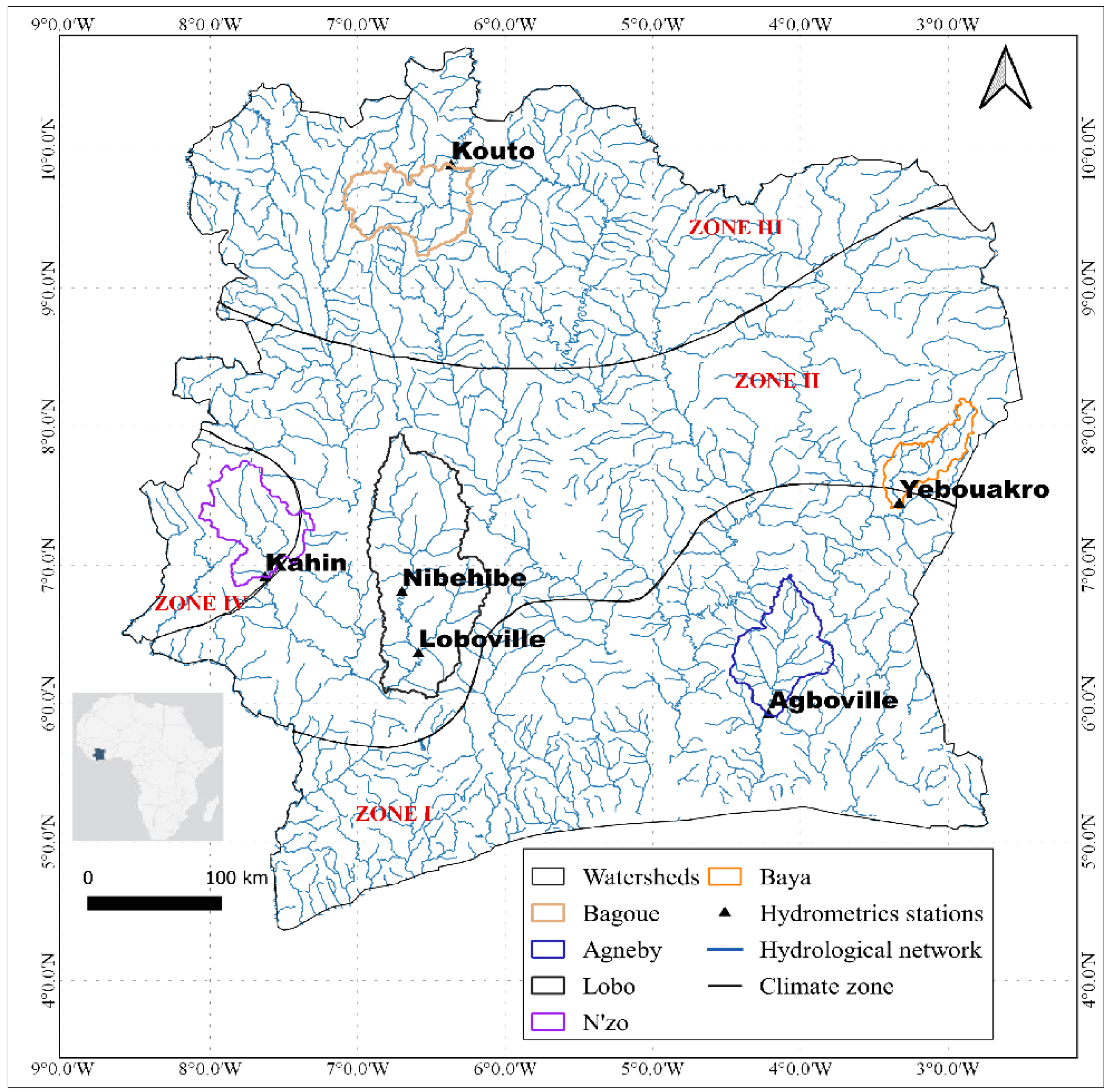
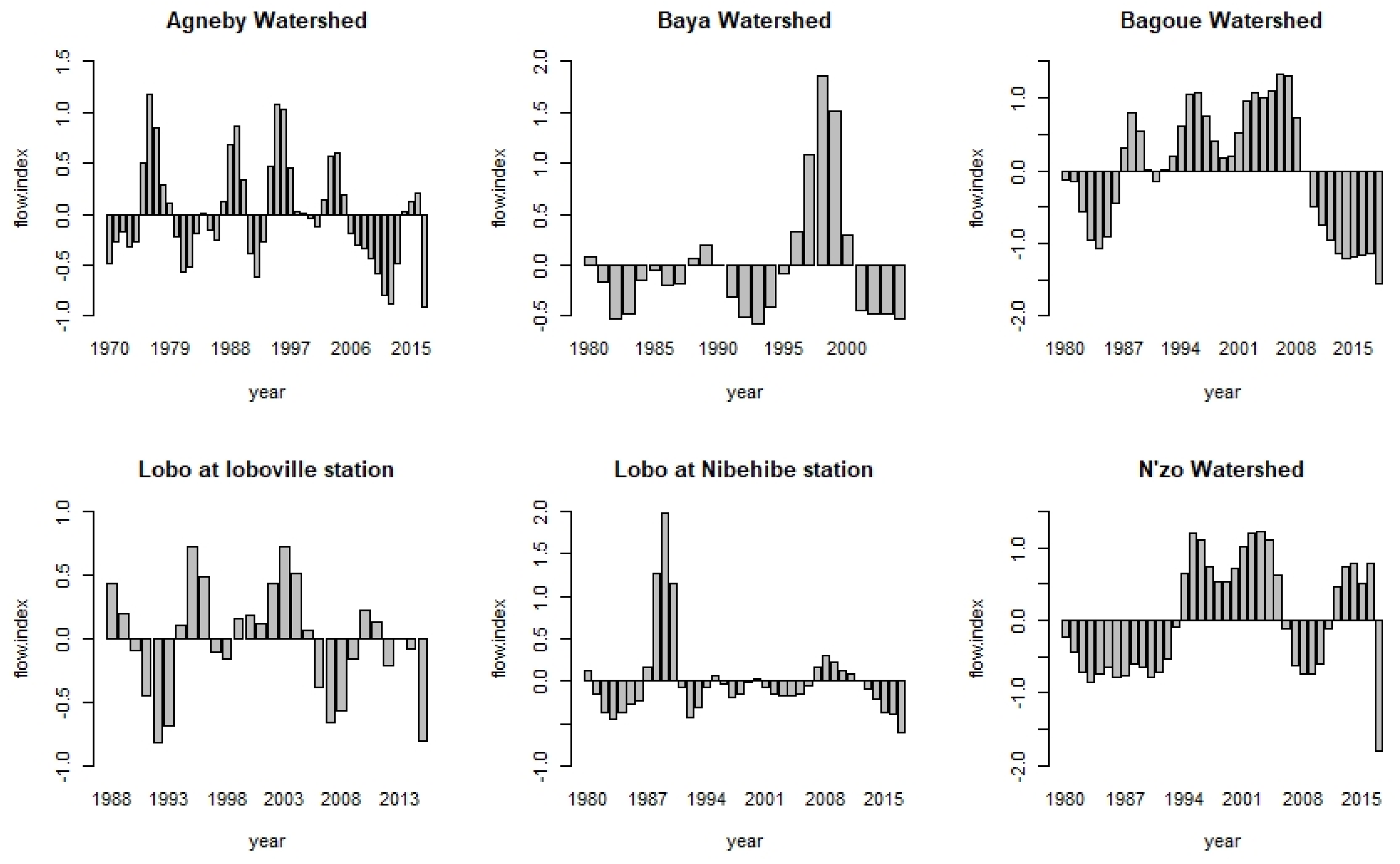
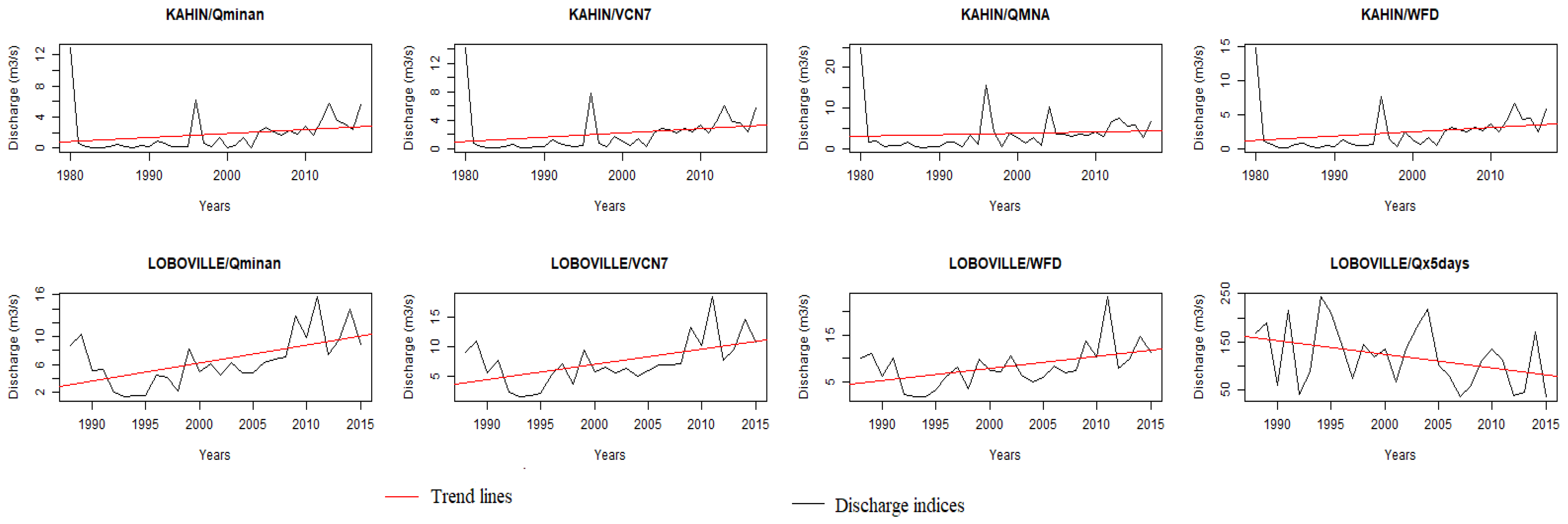

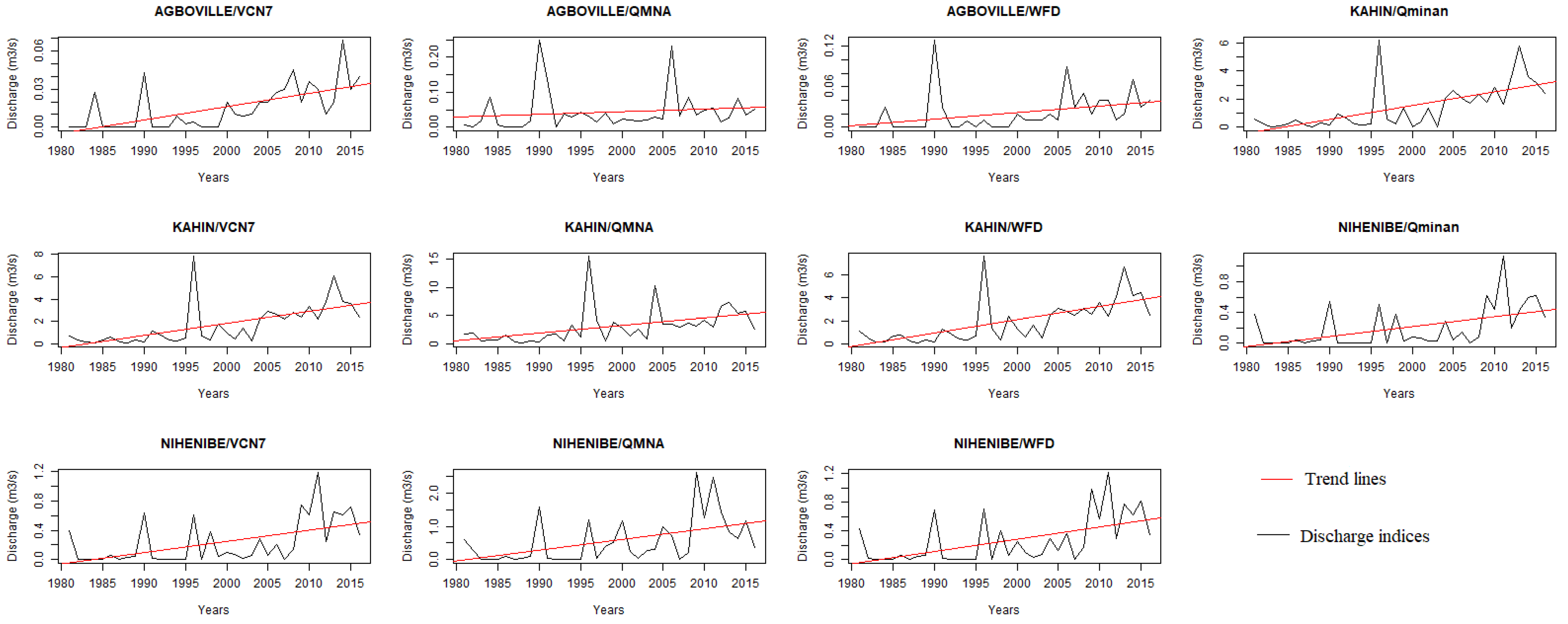

| Climate Zone | Watersheds | Area (km2) | Climate | Characteristics |
|---|---|---|---|---|
| Zone II Equatorial transitional regime Attenuated (Baouleen climate) | Baya | 2266.6 | watershed belongs to the humid tropical climate |
|
| Lobo | 12,660 | transitional equatorial type watershed belongs to the sub-equatorial climate |
| |
| Zone III Transitional tropical regime (Sudanese climate) | Bagoue | 4825.7 | soudano-guineen | single rainy season from April–May to October |
| Zone IV Mountain regime | N’zo | 4458.6 | Mountain characterised by two seasons: a long rainy season lasting 8 months and a dry season of 4 months |
|
| Zone I Transitional equatorial regime transitional (Attieen climate) | Agneby | 8420 | equatorial transition |
|
| Index | Name | Definition |
|---|---|---|
| QX5-days | 5-day maximum flow | Moving average of maximum discharge rate over five days. |
| Qmaxan | Peak discharge | Annual maximum discharge |
| VCX30 | Mean monthly discharge | maximum average discharge over 30 consecutive days |
| Qminan | Annual minimum discharges | The lowest discharge value of the year |
| QMNA | Average monthly discharges | The lowest average monthly discharge for the year |
| VCN7 | Daily discharge rate | Moving average discharge rate over seven days. |
| WFD | Characteristic of low discharge | The discharge rate equals or does not exceed 10 days per year. |
| Trend (MMK Test) | |||||||||
|---|---|---|---|---|---|---|---|---|---|
| High-Discharge Indices | Low-Discharge Indices | ||||||||
| Watersheds | Period of Analysis | Stations | Qmaxan | VCX30 | QX5-days | Qminan | QMNA | VCN7 | WDF |
| Agneby | 1970–2017 | Agboville | - | - | - | - | - | - | - |
| N’zo | 1980–2017 | Kahin | - | ** | - | ** | ** | ** | ** |
| Lobo | 1988–2015 | Loboville | - | - | * | ** | - | ** | ** |
| 1980–2017 | Nibehibe | - | - | - | - | - | - | - | |
| Bagoe | 1980–2018 | Kouto | - | - | - | - | - | - | - |
| Baya | 1980–2004 | Yebouakro | - | - | - | - | - | - | - |
| Watershed | Flood Indices | Low-Discharge Indices | |||||||
|---|---|---|---|---|---|---|---|---|---|
| Period | Stations | Qmaxan | VCX30 | QX5-Days | Qminan | QMNA | VCN7 | WDF | |
| Bagoe | 1970–2017 | Kouto | 2012 * | 2008 * | 1970 * | 1984 * | 1984 * | 1984 * | 1984 * |
| Agneby | 1980–2017 | Agboville | 2013 * | 2014 * | - | 2006 * | - | - | 1970 * |
| Lobo | 1988–2015 | Nibehibe | - | - | - | 2008 * | 2008 * | 2008 * | 2008 * |
| 1980–2017 | Loboville | - | - | - | 2008 * | 2008 * | 2008 * | 2008 * | |
| N’zo | 1980–2018 | Kahin | - | 1994 * | - | - | - | - | - |
| Baya | 1980–2004 | Yebouakro | - | - | - | 1980 * | 1980 * | - | - |
| Trend (MMK Test) | |||||||||
|---|---|---|---|---|---|---|---|---|---|
| High-Discharge Indices | Low-Discharge Indices | ||||||||
| Watersheds | Period of Analysis | Stations | Qmaxan | VCX30 | QX5-Days | Qminan | QMNA | VCN7 | WDF |
| Agneby | 1981–2016 | Agboville | - -- | - -- | - -- | - -- | - ** | - ** | - ** |
| N’zo | 1981–2016 | Kahin | - -- | * -- | - ** | * ** | * ** | * ** | * ** |
| Lobo | 1981–2016 | Nibehibe | - -- | - -- | - - | - ** | - ** | - ** | - ** |
| Bagoe | 1981–2016 | Kouto | - -- | - -- | - -- | - -- | - -- | - -- | - -- |
| Watershed | Flood Indices | Low-Discharge Indices | |||||||
|---|---|---|---|---|---|---|---|---|---|
| Period of Analysis | Stations | Qmaxan | VCX30 | QX5-days | Qminan | QMNA | VCN7 | WDF | |
| Bagoe | 1981–2016 | Kouto | 2012 * | 2008 * | 2008 ** | 1984 * | 1984 * | 1984 * | 1984 * |
| 2008 ** | 2008 ** | 2008 ** | 2008 ** | ||||||
| Agneby | 1981–2016 | Agboville | 2013 * | 2014 * | 2006 * | 2003 ** | 1970 * | ||
| 2013 ** | 2006 ** | ||||||||
| Lobo | 1981–2016 | Nibehibe | 2008 * | 2008 * | 2008 * | 2008 * | |||
| 2008 ** | 2008 ** | 2008 ** | 2008 ** | ||||||
| N’zo | 1981–2016 | Kahin | 1994 * | 1993 ** | 2002 ** | 1995 ** | 2002 ** | 1995 ** | |
Disclaimer/Publisher’s Note: The statements, opinions and data contained in all publications are solely those of the individual author(s) and contributor(s) and not of MDPI and/or the editor(s). MDPI and/or the editor(s) disclaim responsibility for any injury to people or property resulting from any ideas, methods, instructions or products referred to in the content. |
© 2022 by the authors. Licensee MDPI, Basel, Switzerland. This article is an open access article distributed under the terms and conditions of the Creative Commons Attribution (CC BY) license (https://creativecommons.org/licenses/by/4.0/).
Share and Cite
Amichiatchi, N.J.M.C.; Soro, G.E.; Hounkpè, J.; Goula Bi, T.A.; Lawin, A.E. Evaluation of Potential Changes in Extreme Discharges over Some Watersheds in Côte d’Ivoire. Hydrology 2023, 10, 6. https://doi.org/10.3390/hydrology10010006
Amichiatchi NJMC, Soro GE, Hounkpè J, Goula Bi TA, Lawin AE. Evaluation of Potential Changes in Extreme Discharges over Some Watersheds in Côte d’Ivoire. Hydrology. 2023; 10(1):6. https://doi.org/10.3390/hydrology10010006
Chicago/Turabian StyleAmichiatchi, N’da Jocelyne Maryse Christine, Gneneyougo Emile Soro, Jean Hounkpè, Tie Albert Goula Bi, and Agnidé Emmanuel Lawin. 2023. "Evaluation of Potential Changes in Extreme Discharges over Some Watersheds in Côte d’Ivoire" Hydrology 10, no. 1: 6. https://doi.org/10.3390/hydrology10010006
APA StyleAmichiatchi, N. J. M. C., Soro, G. E., Hounkpè, J., Goula Bi, T. A., & Lawin, A. E. (2023). Evaluation of Potential Changes in Extreme Discharges over Some Watersheds in Côte d’Ivoire. Hydrology, 10(1), 6. https://doi.org/10.3390/hydrology10010006






